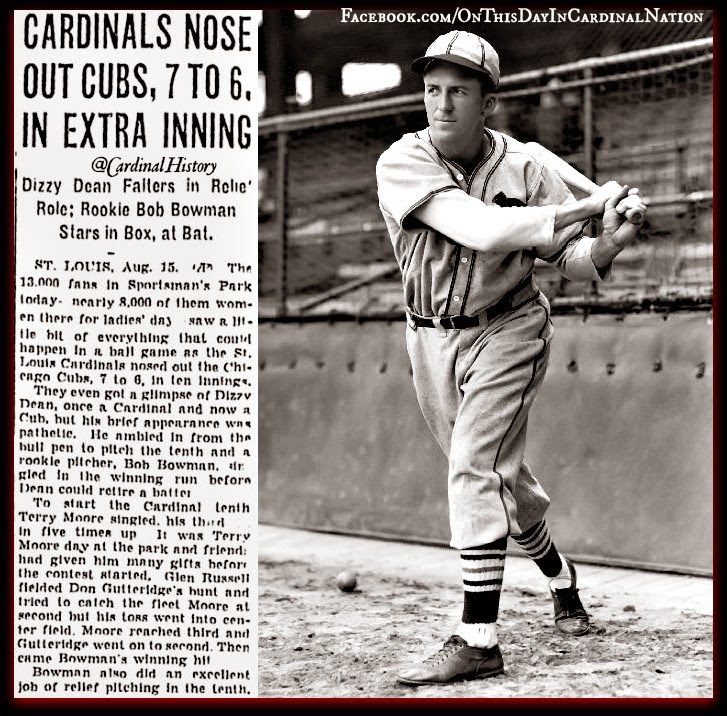Historical Hitter September 5 1935: Terry Moore

On this day in 1935, this rookie center fielder had his best day at the plate going 6 for 6 against the team that often brings out the best in its opposition, the Boston Braves. The game was played in old Sportsman’s Park III needing only an hour and 47 minutes. Yet it was an action filled afternoon matinee that featured 5 Boston errors, 19 St. Louis hits that culminated in the final score of 15-3, with St Louis National Leaguers taking the win.
The official line for Moore was 6 for 6, two runs scored and two RBI, all the hits were singles except a lone double.
Although they finished second to the Cubs in 1935, this mound city nine was had five hall of famers (Frankie Frisch, Leo Durocher, Ducky Medwick, Dizzy Dean and Jessie Haines) on the field and one in the front office, Branch Rickey. As for the Braves, they were worse than the ’62 Mets posting a 38-115 record, a not -so-good enough .248 w-l percentage, a glorious 61.5 GB. To add insult to the agony of defeat, this Beantown nine whose all-star centerfielder Wally Berger, lead the league in Home Runs and RBI, had three errors on September 5, the day in question.
His career was lasted from 1935 to 1948 and shortened by three years for service in WWII (1943 -1945), all in the Gateway City. He was a four-time NL All-Star and finished in the top five in the NL MVP vote five times. Terry Moore presence in the clubhouse in the 1940’s was fundamental to the redbirds success. Named captain of the World Series winners of 1942 and 1946, he was often overshadowed by his numerous Hall of Fame teammates. He was more known for his exceptional fielding prowess than hitting, but he posted a very respectable .280 career average and a career OPS+ of 99. For a five season peak, his OPS+ was 115. After the war, his hitting suffered with his best OPS+ a meager 85. Y If there were gold gloves given during this period, Moore would have collected a trophy case of them. Bill James ranks him number 60 on his center field list, declaring that Moore “was also, of course, one of the greatest defensive outfielders of all time” ( James , 2001).
Branch Rickey keenly saw in him exhibiting the best qualities of baseball leadership, and described him as:
Terry Moore was a real Gashouser. In him burned the fire and determination of a crusader. A Warrior. He asked for no quarter and gave none.
“Captain Terry” was the glue that held the clubhouse together. He was a leader who highlighted the strengths of his teammates as exemplar attitudes. On teammate Jessie Haines’ Hall of Fame web page, clubhouse leader Moore stated:
When I saw how hard a nice old man like Pop could take it after losing a game, I realized why he’d been a consistent winner and the Cardinals, too. I never forgot how much Haines expected of himself and of others.
Unlike most ballplayers who have their day after they retire, as tribute to his leadership “Terry Moore Day” was in the middle of his career held on August 15, 1939. He received “a handful of gifts” which included a hunting dog, 20-gauge shotgun, fishing gear, a gold pin, and coupons to a local barber for free shaves. Moore responding in kind to the adoring crowd by going 3 for 5 with an RBI and two runs scored. His teammates appropriately honored their captain by bringing him home to score the winning run. As world of baseball turns, former teammate Dizzy Dean, then hurling for the Chicago Nationals, took the loss in bottom of the 10 inning. Below is a news story and image taken from a partisan redbird social media posting.

PS. September 5 is a Babe Ruth daily double. In 1914, The Babe, as the Sultan of Swat, hit his only minor league home run in the long-gone Harlan’s Point Stadium in Toronto. Four years later in 1918, The Babe, as pitcher Ruth, pitched a six hit 1-0 shutout of the Cubs in game one of the World Series.
Sources:
Retrosheeet.org
Baseball-reference.com
http://onthisdayincardinalnation.blogspot.com/2014/08/august-15-1939-terry-moore-day-at.html
http://www.baseball-reference.com/boxes/SLN/SLN193908150.shtml
http://baseballhall.org/hof/haines-jesse
James, Bill, The New Bill James Historical Baseball Abstract, Free Press (2003).
Monteleone, John, Ed., Branch Rickey’s Little Blue Book, MacMillan (1995).
